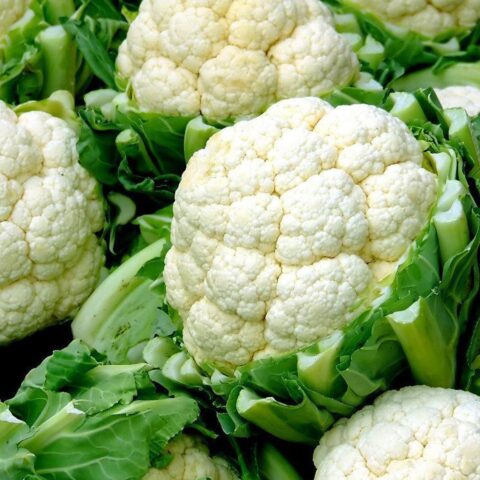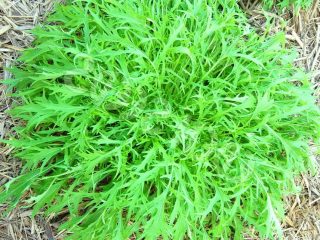Content
Cauliflower does not set for various reasons. They are mainly associated with improper care - untimely watering, lack of fertilizing or unbalanced composition. Also, the absence of an ovary may be a consequence of the characteristics of the variety, weather conditions or diseases.
When does cauliflower set in open ground?
Normally, a head of cauliflower is set in the period from 80 to 170 days from the moment of mass shoots. The specific timing depends on the characteristics of the variety:
- early ripening - after 80-110 days;
- mid-season - after 125-135 days;
- late - after 160-170 days.
Time periods may vary slightly - an error of 10 days is allowed. This depends on the care of seedlings and adult plants, and weather factors.But if the head of cabbage does not set within, for example, three months (for early varieties), this is a clear deviation.
How to tie cauliflower
First, the plant produces a powerful central shoot, from which leaves emerge. They quickly increase in size and darken - becoming a rich green color.
3-4 months after the emergence of seedlings, a head of cabbage begins to form. It consists of white inflorescences that form “islands”, fused together and reminiscent of a dense bouquet. The surface is embossed, with pronounced grooves.
In fact, this is not a head of cabbage in the usual sense, but inflorescences. Forks as a set of leaves are used in white cabbage and Chinese cabbage, while in cauliflower it is the inflorescences that are used for food.

The head is formed 3-4 months after germination
Why cauliflower doesn't set in heads
If cauliflower doesn't set well, it could be due to several factors. Often the cause is errors in care. There may also be objective factors - characteristics of the variety or bad weather conditions.
Wrong variety
If cauliflower produces a lot of leaves, but there is no ovary, this may be a consequence of the wrong variety. This phenomenon is observed if you purchase seedlings or seeds by hand or from a less trusted manufacturer.
Sometimes, to obtain new varieties, a seed plant is crossed with another crop, resulting in the formation of a first-generation F1 hybrid. It has good hardiness and produces a lot of foliage, but the cauliflower heads do not set. Therefore, it is better to purchase seeds or seedlings only from reputable suppliers, including nurseries.
Each variety has its own characteristics.There are early, mid-season and late-season cabbage. It must be planted within a certain period of time, otherwise the cabbage will not set.
They are adapted to the climatic conditions of the country and, with proper care, are guaranteed to produce a good harvest.
Poor quality seeds
Low-quality seeds are usually supplied only by unscrupulous suppliers. When purchasing, it is recommended to study reviews from gardeners on special websites and forums, and always check the expiration date.
After purchasing cauliflower seeds, they are carefully selected, leaving only the largest and most undamaged ones. It is also recommended to conduct a test - put the grains in salted water (a tablespoon per 1 liter) for 20 minutes. Some seeds may float to the surface - then they are discarded. If you do not do a preliminary check, germination will be lower, and the heads of cabbage will not set.

Planting material is purchased from trusted suppliers
Poor quality seedlings
Healthy seedlings should be tall enough (at least 10 cm when transplanted into soil) and have several large, elastic leaves. It should not show any signs of disease, including darkening of the root collar (black leg).
The best option is to grow seedlings yourself. But if the deadline has already passed, you can purchase it. When purchasing, seedlings are carefully examined: if in doubt, it is better not to take them.Incorrectly grown seedlings are initially weakened, so later cauliflower forks will not form.
Unsuitable soil
Almost all varieties of cabbage are demanding on soil. It should be fertile and loose, with a minimum clay content. The reaction is neutral or slightly acidic - pH from 6.0 to 7.0. The bed should be well lit and located on a small hill to avoid flooding by rainwater.
If the soil is depleted, it must be fertilized 1-2 months before planting. To do this, it is recommended to add compost or humus in an amount of 8-10 kg per 1 m2. It also happens that the soil is too heavy and dense. Then sawdust or sand is embedded in it - 1 kg per square meter.
If the pH is less than 6.0, the soil is too acidic. You need to add 100-200 g of wood ash or dolomite flour per 1 m22. The pH measurement is first carried out using indicator paper or a pH meter.
Nutrient deficiencies
If cauliflower does not set flowers, it is often due to a lack of fertilizer. This phenomenon is observed if the soil is infertile, and the summer resident does not provide fertilizing or does so rarely and in insufficient quantities. Therefore, it is important to ensure regular fertilization. At the beginning of the season, nitrogen compounds (urea, ammonium nitrate) are added, and then potassium and phosphorus.

To form the ovary, it is necessary to regularly feed the plants.
If the cauliflower is stretched out and the forks are not tied, this may be due to both a lack of fertilizer and improper application. It is important to fertilize in moderation (overfeeding is worse than underfeeding) and provide the plants with a variety of fertilizers with a balanced composition.
Lack of moisture
If the head of cabbage does not set, this may be due to violations of the watering rules. Cauliflower is sensitive to even short-term drought. Moreover, it is important for her to provide not only good watering, but also sufficiently humid air.
If there is no rain, water is given at least once a week. The consumption rate is a bucket (10 l) for each square meter. If drought occurs, watering is repeated every 2-3 days. At the same time, it is important to ensure that the soil is not flooded or too wet - otherwise the roots will begin to rot, and some of the plantings may die.
To keep the soil moist longer, it must be mulched with straw, hay, sawdust, dried grass (mowed before flowering so that it is seedless) or other materials. After watering or heavy rain, the surface layer of soil must be thoroughly loosened. This will provide oxygen access to the roots, so the heads of cabbage will set faster.
Planting density
If cauliflower does not set in the greenhouse, the determining factor is often that the planting is too dense. On the one hand, space in the greenhouse really needs to be saved, but on the other hand, not to the detriment of the plants. When planting, an interval of at least 40-50 cm should be maintained. Seedlings are distributed in a checkerboard pattern, away from tall plants, fruit bushes and trees. This will ensure uniform access of sunlight to all plantings.
Influence of weather conditions
If cauliflower forks do not set, the reason may also be due to unfavorable weather:
- Cabbage does not tolerate too large temperature changes.
- Extreme heat, when the temperature rises above 30 degrees, is also harmful. Because of this, metabolic processes in tissues are disrupted, including the production of plant hormones. As a result, the head of cabbage does not set and becomes ugly or small.
- Cauliflower does not tolerate too much cold when the temperature drops below 5-7 degrees Celsius.

It is advisable to grow plants in a greenhouse
To avoid these consequences, it is necessary to comply with planting deadlines. In most of Russia, seedlings are transferred to open ground no earlier than the first ten days of May, when the threat of return frosts will be minimized. If the region experiences a cold spring and early summer, it is recommended to grow the crop in a greenhouse.
Diseases and pests
When cauliflower does not set for a long time, the cause may be diseases and pests. They can interfere with both seedlings and adult plants. Cabbage moth is especially dangerous. Its caterpillars eat the tissue around the leaf heart, which is why the head of cabbage does not form or is too small.
To combat the pest, folk remedies are used, for example:
- infusion of celandine, lavender or citrus peel;
- decoction of tomato tops;
- tobacco dust solution.
These compositions help cope with moths in the early stages. If the invasion is severe, chemicals are used:
- "Ambush";
- "Dipel";
- "Kinmiks";
- "Bactospein";
- "Gomelin";
- "Nurell" and others.
Treatment is carried out in the evening, in dry and windless weather.At the same time, the waiting period is taken into account - the minimum number of days from the moment of the last spraying until harvest.
What to do to get cauliflower to set
There are many ways to help cauliflower set. First of all, carefully select the variety, prepare and discard the seeds. When landing, observe the interval.
It is also necessary to ensure proper care:
- regular watering;
- fertilizing;
- cover overnight with non-woven fabric (in the first stages of cultivation);
- hilling;
- preventive treatment against diseases and pests;
- in hot weather, plantings are shaded with a white shield.

Proper care guarantees the formation of the ovary
How to feed cauliflower for ovary
Since cauliflower often does not set due to lack of fertilizer or unbalanced nutrition, the first step is to fertilize it. You can use different means - folk, complex fertilizing, as well as organic matter (it is added 1-2 months before planting).
Folk remedies
Among the most effective folk remedies, thanks to which heads of cabbage set normally, the following can be distinguished:
- Baker's yeast - microscopic fungi stimulate the absorption of nutrients by plants, thereby improving metabolic processes. To prepare the solution, take a bag of dry or 100 g of fresh yeast and dissolve it in a bucket of warm water. Add 2 tbsp there. l. sugar and leave for several hours. Thanks to the application of fertilizer, the head of cauliflower sets well.
- Boric acid serves both as a fertilizer, thanks to which the head of cauliflower sets well, and as a preventative against pests.To process the tops, before starting to form the fork, they are treated with a solution (2 teaspoons per 10 l). The powder is diluted in hot water, then allowed to cool.
- Green fertilizer will also help cauliflower - mow down the weeds, fill half the container and fill with water. Leave for a week, stirring occasionally. Then filter and dilute with water five times, after which they begin to water the cauliflower. Thanks to this, the head of cabbage begins to form.
Complex fertilizers
In order for cauliflower to set, it is necessary to fertilize with complex fertilizer:
- “Azofoska” contains phosphorus and potassium along with nitrogen. Used for watering plants in an amount of 50 g per 10 liters.
- “Nitrophoska” is a fertilizer with a predominant nitrogen content; it is applied at the beginning of the season. The solution is prepared based on a ratio of 30 g per 10 l. It must be added in cases where the head of cauliflower does not set.
- “Orton” is a ready-made complex fertilizer that contains not only basic substances, but also microelements, as well as organic humic acids. If the head of cabbage does not set, water it with a solution of 20 g per 10 liters. Fertilizing is applied up to three times per season with an interval of 10 days.

"Azofoska" is an effective and inexpensive fertilizer that ensures the formation of ovaries
Instead of these fertilizers, you can use other compositions - “Solution”, “Kemira Lux”, “Zircon”. They not only enrich the soil with nutrients, but also stimulate growth processes. This is especially important in the first month after transplanting seedlings into open ground.
It is recommended to completely exclude them until the end of the season.Instead, the emphasis is on potash compounds and superphosphate.
Useful tips
If the head of cabbage does not set, this is most often due to improper care. To avoid such problems, experienced summer residents recommend using the following tips:
- Avoid the following precursors: carrots, radishes, beets or any varieties of cabbage. Because of them, the crop grows poorly and the head does not set.
- Plant in beds where legumes, cucumbers, eggplants, peppers or zucchini have recently grown.
- If the cauliflower head does not set, put out a garden sprinkler and use it in dry weather. If there is no device, spray the plantings with water in the late evening. You can add salt to it - a teaspoon per liter. This product will serve as additional prevention against pests.
- When cabbage inflorescences stretch out, spread out, and the head does not set, it is necessary to apply complex fertilizer. It promotes the formation of a fork.
Conclusion
Cauliflower does not set for various reasons, which in most cases are quite possible to influence. It is necessary to carefully select the variety, discard unsuitable seeds, and take into account the timing of planting. It is also worth providing normal care, especially regular watering and fertilizing.








